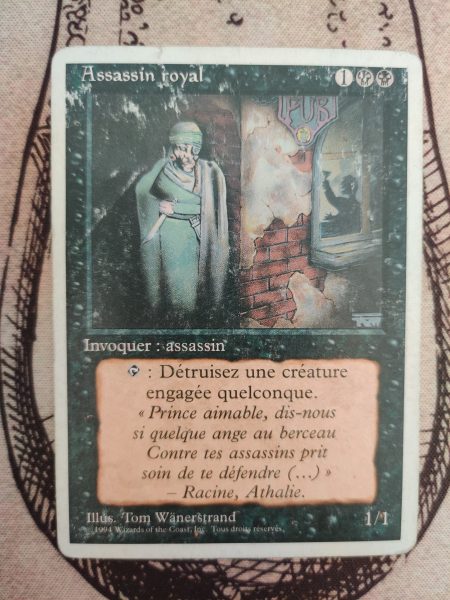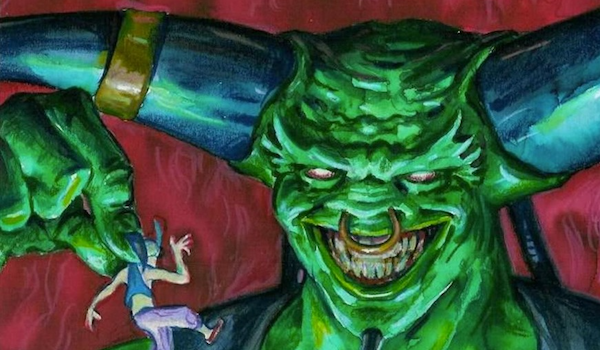Are you a Quiet Speculation member?
If not, now is a perfect time to join up! Our powerful tools, breaking-news analysis, and exclusive Discord channel will make sure you stay up to date and ahead of the curve.
Expect my visit when the darkness comes.
The night I think is best for hiding all.
Today, we are precisely halfway through out journey around the color pie. After dealing with the color philosophy of White (split into Part 1 and Part 2) and Blue, it's now time for Black. The color of swamps, zombies, and rats is possibly the most misunderstood, since it's often considered the color of pure evil. In fact, as we'll see in the course of this installment there is more to it than just that, although Black certainly presents its share of wickedness.
In the course of this series of articles, based on flavor texts coming from real-world literature, we have already made our acquaintance with a considerable number of Black cards—more than any other color, in fact. The reason? It just turns out that Black has a strong presence among this specific set of cards. This allowed us to dedicate it a couple of articles: one centered on quotations from Dante, Stoker and Conrad, and one about horror-themed cards from the set Legends.
Anyway, we should still have enough cards to show what Black is really all about. Let's start with a quick overview on this color's philosophy, and then move to a card-by-card analysis.
Black Color Philosophy
Black is generally associated with selfishness, ambition, amorality and parasitism. Black wizards seek power above everything and don't care how they are going to reach it. On the other hand, they show quite an overt style: seldom are they ambiguous as other colors do. With such macabre themes it's particularly easy to tell a black card apart on the art alone, and that was true even at the earliest stage of this game.
Greatness, at any cost
One of the main characteristics of Black is the will of domination, no matter the price. Or, to borrow Dark Confidant's words: "Greatness, at any cost". The price to be paid is both moral and practical in nature: many black cards come with strong effects, but the strongest ones frequently demand creature sacrifices in the form of activation costs or upkeep.
Juzam Djinn
Expect my visit when the darkness comes.
Wallada bint al-Mustakfi, Darkness
The night I think is best for hiding all.
Let's start off with a bang, as Juzam Djinn is among the most celebrated black cards ever. Particularly beloved by old-school card connoisseurs—as you can see from the price tag—it has an established reputation as a collector's piece. And in the early days, it was also extremely powerful.
From a color-philosophy perspective, it's one of the most iconic early examples of Black's defining traits. Its stats were way above average back in 1993, but this came at the price of losing life every turn. We have seen a similar mechanic in plenty other Black cards since then, such as Dark Tutelage, or Carnophage, which we discussed for its quote from Dante.
The Djin's flavor text comes from Darkness, a poem by Andalusian poet Wallada bint al-Mustakfi, who lived in Cordova during the eleventh century. As is often the case, the use of hendecasyllablic meter gives the text a grandiose musical quality, which works marvelously here to amplify the sinister aura of the beautiful yet terrifying Djinn.
Creature Destruction (and Sacrifice)
Another typical feature of Black is its proficiency in all manners of assassination. As we have noted in the introduction, dark wizards stop at nothing to achieve their ends. We have already seen cards such as Dark Banishing, so let's take a look at a couple more of variations on this theme.
Royal Assassin
Say, did an angel at thy cradle side, beloved prince!
Racine, Athalie
Against thy murderers defend thee with his care?
This is a special case, since the quotation above is only present in the French version of FWB (Foreign White Bordered). And in fact, it's a citation from French poet Racine, from his last tragedy titled Athalie. This choice is quite rare in Magic, as it's one of the few cards with a flavor text using this particular meter. Instead of the popular hendecasyllablic this quote is in iambic meter—a style originally used in Greek tragedy and comedy, which later became popular among English and French poets writing on tragic subjects. If you are curious about the original, you can find the French text in the photo below.

Back to color philosophy: I regard Royal Assassin as a card similar to Archivist, which we touched upon in a previous article. Both cards are expensive and puny in terms of strength and toughness; three to four mana is a lot to pay for a 1/1. However, they possess abilities that make them more than worthwhile, and transform them from mediocre fighters to prized creatures. Not to mention their extreme fidelity to their respective colors. One lets you draw cards, the other lets you kill creatures. What could be more Blue or more Black than that?
Cruel Edict
No mockeries now for them; no prayers nor bells,
Wilfred Owen, Anthem for Doomed Youth
Nor any voice of mourning save the choirs,—
The shrill, demented choirs of wailing shells.
Cruel Edict might be the darkest of all these cards, at least when it comes to its flavor text. Not from a purely horrific point of view, but rather because of its heartbreaking antiwar message. Wilfred Owen, mostly known for his poem Dulce et Decorum est, was an English poet and soldier. He fought in the Great War and was killed in action at the age of 25, but he left behind some celebrated war poems reflecting upon his experience and the horror of trenches.
As for the card itself, Cruel Edict is a sorcery that forces your opponent to sacrifice a creature. As is always the case when it comes to sacrifices, the player doing the sacrificing gets to choose which creature to axe, but it still stings. This is particularly useful for overcoming keywords such as "indestructible," "hexproof," "shroud," "protection," and so on. Not bad for just two mana!
Life-Steal and The Like
Black is good at making the opponent lose life, but also sometimes at gaining life as well: often you can see both mechanics within the same Black card. If Red is more about dealing damage (as we'll see in the next installment), Black is more about losing and gaining life. Let's see a few examples.
Dakmor Ghoul
Cursed be the sickly forms that err from honest Nature’s rule!
Alfred, Lord Tennyson, Locksley Hall
This creature is quite unimpressive on its own, and in fact it has been relegated to the set Starter 1999, dedicated to beginners. It's just a 2/2 Zombie for four mana, and when it enters the battlefield you gain 2 life and your opponent loses 2. The only reason why I'm mentioning it is that it's double effect is a regular feature of many black cards.
Just to see another example, look at Syphon Soul. This time, the card is a sorcery, but the function remains the same: you gain life, your opponent loses life. It's as simple as that, and black surely makes it look simple!
Underworld Dreams
In the drowsy dark cave of the mind, dreams build their nest with fragments dropped from day’s caravan.
As for Underworld Dreams, it mixes up two skills typical of Black. On one hand, we have an ability to make your enemies lose life (though here it's actually direct damage). On the other hand, we also have Black's obsession with hand manipulation, be it drawing or discarding. Normally, Black makes the opponent discard cards, or make them suffer when they do so, or both. In this case however, it takes the opposite path, and punishes them for drawing cards.
This dual approach to the matter reminds me of the couple The Rack and Black Vise. Both were illustrated by Richard Thomas, which made them one of the most famous couples in Magic history. Yes, they are both artifacts, but they are also very black from a color philosophy perspective!
Conclusions
We have now seen a bunch more black cards. Even though we had already covered most of them when focusing on the horror-side of the color Black, we have now focused more on this color's philosophy. Black is interested in acquiring power, at any cost.
As for the means, these are usually either stealing life, or sacrificing creatures. Through such sinister methods you can acquire some of the most powerful cards in this game, although the price can be quite steep...
What do you think of the color Black and its philosophy? Can you think of any notable cards, perhaps outside the realm of real-world quotations? If so, let us know in the comments! We are going to finish this series soon, so make the most of it while you can, and stay tuned for the last two colors: Red and Green.





